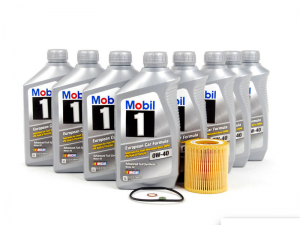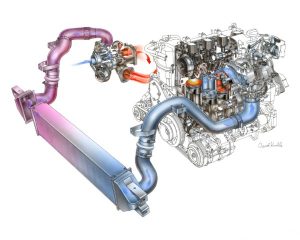The fuel delivery system in a new car costs more than the entire engine used to.
And still does – if you’re lucky enough to own a V8-powered American car or truck built before the mid-1990s. If you do, you can usually buy a brand-new/manufacturer-warranted crate engine for about $2,000.
Compare that with the cost of a modern car engine’s direct-injection fuel delivery system – resorted to as a way to eke out another 2-3 MPGs vs. port fuel injection.
You don’t want to know . . .
If you ever have to replace the transmission in a car built since about 2010, better have smelling salts nearby. The tab for an eight/nine-ten-speed or “dual clutch” automatic – which the car companies have resorted to in order to eke out another 2-3 MPG vs. a four or five-speed overdrive transmission – can run as high as $5,000 – not counting the labor to install the beast.
If the air bags go off, the car is usually a total loss. Even if the car itself could easily be repaired. Because just replacing the driver and front seat passenger air bags can cost several thousand dollars – before a cent is spent to fix bent fenders. It’s easy to reach the financial threshold beyond which the car is not worth fixing.
These are just a few of the Costs of Uncle – the costs to us of the regulatory burden imposed by the government.
But there are other Cost of Uncle not as obvious.
One of these is the cost of changing a modern car’s oil. Because for openers there’s more oil to change.
I began to notice this during the course of doing the background research I always do prior to writing a review of a new car. A trend became apparent: New car engines may be smaller – but their oil capacities are greater.
This is particularly apparent when it comes to modern four cylinder engines – most of them in the 2 liter-ish range and turbocharged, to make up for their small size and (absent the turbo) insufficient power. Ford’s 2.3 liter “EcoBoost” four, as an example, has a capacity just under six quarts – about the same amount of oil required by the 7.4 liter V8 in my ’76 Pontiac Trans Am.
It costs as much to change the EcoBoost four’s oil as it does to change the oil in my old muscle car, which has an engine nearly three times as large.
Costs more, actually – because the Ford requires $10-plus per quart synthetic oil. Which it does because it’s turbocharged. Turbocharged engines run hotter and their internals are subjected to additional stress because they are literally pressurized. That is (cue Dr. Evil voice) what turbochargers do.
But turbochargers used to be rare.
They were generally added to increase the power of an already powerful engine. To make a sporty car sportier. The reason turbos are now as common as air bags is because they are being resorted to by the car companies to make up for power lost as the result of installing smaller engines in cars, including ordinary family cars.
Federal fuel economy fatwas have made V8s – and more recently, six-cylinder engines – as rare as ashtrays in new cars. You can still find them here and there, but they’re usually optional and not cheap.
Which is another Cost of Uncle.
V8s and V6s depress a car company’s Corporate Average Fuel Economy (CAFE) number.
The MPG difference between a six and a turbo four usually isn’t much – about 3-4 MPG overall is typical. It doesn’t seem like a lot – and it’s not, on a car vs. car basis. Hardly worth the fuss – or the cost.
But when scaled and factored over a car company’s entire yearly output – which is how CAFE averages are calculated – it does matter.
A great deal.
If the CAFE average dips too low, the “gas guzzler” fines appended become onerous; the company is at a competitive disadvantage vs. rivals whose cars aren’t saddled with exorbitant “gas guzzler” fines.
The only way to tilt the scale back in the government’s favor is to sell fewer cars (and other vehicles, such as trucks and SUVs) equipped with engines larger than four cylinders. The easiest way to do that is to make engines larger than four cylinders optional – and extra cost.
This has the side benefit of recovering some of the money that goes to pay the fines for failing to meet the CAFE average.
Paid for by the people who buy the cars, of course.
Never the fatwa-issuers.
The saying has it that there’s no such thing as a free lunch and that saying is even more true when it comes to the Cost of Uncle. People fall for it every time when a glib-gabbling, Tele-Prompter’d politician promises to wave his authoritarian wand and give them cars that get better gas mileage, are “safer” or some other boon.
But none of it comes free.
Uncle’s minions simply take the credit – and hand the bill to the marks who thought they were getting something for nothing.
If you like what you’ve found here, please consider supporting EPautos.
We depend on you to keep the wheels turning!
Our donate button is here.
If you prefer not to use PayPal, our mailing address is:
EPautos
721 Hummingbird Lane SE
Copper Hill, VA 24079
PS: EPautos stickers are free to those who send in $20 or more to support the site. Also, the eBook – free! – is available. Click here. Just enter you email in the box on the top of the main page and we’ll send you a copy ASAP.











Take a Lamborghini Huracan to the dealer for an oil change and it’s $600.
The other reason oil capacities have gone up is to offer extended change intervals. During a typical auto lease period, the oil might only be changed 2 or 3 times. Is this workable? Not really – even with the increased oil supply the high-stress motors use up the additive package just as fast. So you still want to be changing at 5k mile intervals (not the 10k or 15k that some car makers like BMW say is ok). Remember – sludge just has to not be a problem until after the warranty runs out.
“the Ford requires $10-plus per quart synthetic oil”
Ford requires Motorcraft synthetic blend 5W-20. Walmart sells it in the qt bottle for $4.38 or $18.53 for the five qt jug.
Even mobil 1 is generally $22 to $26 for the five qt jug. I suppose if one buys amzoil or royal purple or something in qt bottles it might get to $10/qt. Even Mobil 1 at an auto parts store in the qt is the $8/qt range.
Amsoil engine oil along with their filters are bargains for people who put a lot of miles on their cars.
I’ve changed friends cars who do a lot of road work to Amsoil and they have the figures to show the advantage. Even changing Amsoil and filter every 6 months when you don’t have 25,000 miles on it is not necessary as they recommend if,like my vehicles, you never drive less than 30 miles and mostly at least twice that every time you use it.
This isn’t my opinion but the result of having oil tested, something you can do once when your driving is virtually the same on a regular basis.
YMMV depending on where and how you drive.
Our 2 year old mower hasn’t been run in nearly a year so I was surprised to see it low on fuel. I intended to start it and run it till the oil was warm and then change it and the filter. Looks like I’ll be changing it cold.
This is a virtually new Kohler. I haven’t had a carb do this since my old Lincoln 225 Red Face would do it if the fuel wasn’t turned off. I see a fuel cutoff in the mowers near future.
I picked up a reconditioned Kohler at Home Depot about 5 years ago. I only use ethanol free gas and I always run the gas out of it. I have a big enough place that I always run out before I get done so I just do the front yard first, then finish in a different corner each time so it never gets too tall. About two weeks ago that piece of crap practically self destructed. It stopped running, the pull cord snapped, I fixed the pull cord, but then the retractable mechanism malfunctioned, then the bolts that hold that safety crap housing for the retractable cord mechanism became stripped, then the safety lever for the blade broke. I couldn’t get one part fixed before something else broke. The best part is that I bought the thing knowing it probably wouldn’t last more than five years. Not the best $150.00 I ever spent, but it wasn’t the worst deal either. I’ve got a neighbor down the street that raises goats for less than $120.00 I’m going to look into them as my next mower/fertilizer.
Perhaps you should use geese or ducks instead. https://www.backyardchickens.com/threads/geese-or-ducks-which-is-better.924127/
Nah, I already have chickens. Geese and ducks are messy, and they don’t eat grass. Goats will chew the grass right down to the roots, eat all the weeds, and drop these nice dry little pellets that you never have to worry about tracking into the house.
I tried posting both of my replies as only one message, but the WP spam alert prevented that. Perhaps you should use hair sheep instead. www dot sheep101 dot info/201/hairsheep dot html Goats are escape artists. It is said that if you can toss a bucket of water through a fence; then it isn’t goat proof.
They can’t chew through chain or chain link fencing. It’s pretty simple to just put it on a chain staked to the ground. When they have that area cut down where you want it, you just move the stake to the next area that needs to be cut. Sheep are high maintenance compared to goats. I’m not looking for another job.
All this crap started with idiots asking the “government ” to do something about some piddly-stupid shit. When are people going to get it through their thick skulls that you don’t ask the government for anything? It’s like nagging your parents for everything. They will treat you like a retarded child, and then use the same excuse that parents used for whipping everyone when only one of you misbehaved – “if one of you gets it, your all gonna get it”! Govt. assholes don’t “provide” anything but edicts and mandates, and then rob you at the point of a pen (lest you want the badge and gun instead), just for asking!
You got that right. People want the society managed like they were managed in grade school. Another reason they took the schools first.
Eric,
“hands the bill to the marks who thought they were getting something for nothing.”
Love that line!
The big con, the Nobel lie, hard to believe it still works after centuries.
I’m starting to think it works even better today.
T,it does work better now. More marks, a great deal more, and more “enforcers “, a huge amount more.
When a non working back up lamp on a road tractor is $200 it’s a hell of a good revenue increaser. The DOT is rolling in money. They even use the laptops made for combat zones. Hell, they could gold plate them if they wanted.
The boss had an early 2000s Harley. While coming back from Sturgis he started having problems with it randomly shutting down. The prognosis was that the fuel injection system was bad and needed replacing. The bad news was that none of the parts are available from the factory anymore, so it was doubtful he could find anyone to work on it and if he wanted to do it himself he’d likely be spending a lot of time in front of the computer looking for them. Then once installed he’d probably run into the same issue down the road anyway. The alternative was to install a carburetor.
Long story short, he’s got himself a new bike.
Hi RK,
That’s one of the reasons I dislike FYI. Like a sail fawn or computer or other such gadget, they work – until they don’t. Hard to fix by the side of the road with a screwdriver – or just get running well enough to get you home. Usually, it’s just – kaput.
And call The Man.
So glad GM has that information Center. I changed plugs and wires and everything was fine. So I high pressure the bottom of the driveline to make servicing the transmission at least a bit cleaner since I have a drain plug kit to install in the pan to avoid the transmission fluid clusterfuck next time, just think, draining into a bottle instead of having me, the creeper tand 100 Sq feet of floor to clean.
Being the anal guy I am for cleanliness I cleaned the entire engine compartment too
Fire it up and it has a partial miss that doesnt go away after 30 minutes of operation. Check Engine light comes on. Glad that works, can’t imagine why it’s on.
I haven’t had a vehicle cut out from engine washing since my last points distributor and that was always a quick and easy fix.
Since it’s only a partial miss I can see this taking forever to find the problem. Pull a wire, go ahead, just pull any wire
and get a full miss. Pull each wire and get a full miss and once they’re all back on have a partial miss. Replace a coil,partial miss. Change back to the original coil and move the new one to a different plug, partial miss. Do this on every cylinder and have a partial miss.
I haven’t done all this yet. I used to have, before someone needed it more than me, a little device that looked sorta like a ballpoint pen. It had a spark plug wire size divot on the end with a window you could see the spark on any plug wire and find a partial or complete miss in just a minute going from wire to wire. That was such an easy way to find a partial or complete miss I’d just go down each side of the engine and find the problem nearly instantly. I used it on every engine I came across with a miss. It was fast and foolproof. Once gone I tried to replace it, went back to the store where I bought it. One guy recalled it but they no longer had them and didn’t know how to get another. I’m pretty sure it was a Champion tool but have never found another.
WTF was wrong with a rotary distributor? Easy and cheap to fix.
Now GM has me playing their version of the “shell” game. The hand is quicker than the eye…….shit
Thats why I like old school. The EFI and Electronic ignition are great for my appliances. I can get by with just driving my 10-20 year old stuff into the dirt with only “after the fact” maintenance.
But I always go by the standard of, “If it breaks down in the middle of the Sahara desert, can I fix it with my tools and a few cheap spares like points, or am I going to die?” Note also that this applies equally well to the imminent threat of EMP/Solar storm problems.
On my old pickups a roll of electrical tape, a roll of aluminum tape, a few rounds of electric fence wire, some electrical connectors, a beer can and a coffee can of small parts….so if you didn’t need the small parts the coffee can was good for lots of fixes. Throw in a couple 4 inch clamps and some old inner tube, a few extra quarts of engine oil and ATF, a dammit jack and the usual suspects toolwise and you were ready to circle the globe…..plus a good chain, no straps needed.
Yep: I have 2000 Dyna Glide, and I *specifically* chose that year since it was the last year of the carburetor. Having rebuilt and rejetted the carb on my old Sportster, I *knew* how that device worked. (to mean the physics and engineering behind the design of the carburetor itself) I daydream about new Harleys as a replacement for my old Dyna, but nowadays (and as I get older) I’m thinking, “Nahhhh”. To me, one of the best things (if not *the* best) about a motorcycle is the simplicity of the engine, and the ease at which I can perform damn near all the maintenance and fixing. If motorcycles become just as complicated as any car, (which they damn near are now) then I might just as well buy a nice convertible.
Even the new HD’s are crap; it’s still just horse and buggy technology with a bunch of technological crap wrapped around it. How come the Amish don’t have to put all this crap on their horse and buggies? I just sold my chopper which was a job just to keep it from rusting to pieces. I’m selling a Suzuki sport bike that practically thrives on neglect. It runs as good as the day I bought it so I’m even having second thoughts about selling it. I’m definitely in no rush to sell it for much less than the asking price.
There’s something to be said for being able to work on a vehicle, but then there’s also something to be said for needing to work on vehicles. I didn’t mind working on my old shovelhead or my old cars, but back then I was young, and it was just part of life. Then I bought a Hyundai Elantra, and when something finally did break (the license plate light needed to be replaced) I was practically clueless. I couldn’t remember where my tool box was I hadn’t seen it in such a long time. When I finally sold it after practically beating it to death with a few hundred thousand very hard miles, I just went out and bought another Hyundai. It’s like Eric was saying about how with older cars a transmission might be a couple thousand verses the newer models being upwards of $5 to 10k. I remember needing to get a car years ago and just went down to the tow yard and picked up a Nissan Sentra ($140.00) towed it to a shop, and had the guy install one of those 30k mile blocks straight from Japan. The replacement engine was $500.00, ;labor was $250.00; $40.00 to cut a new key; and the tow was free with AAA. I drove it around for six months and sold it for $2,200.00